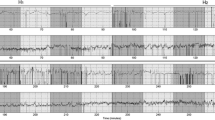Abstract
Objectives
To evaluate the efficacy of vibroacoustic stimulation (VAS) and modified fetal biophysical profile (mFBP) for early intrapartum fetal assessment and prediction of adverse perinatal outcome.
Methods
In this prospective study, 210 women who were in latent phase of labor at the time of admission to the labor unit were subjected to VAS/mFBP, in which fetal startle response and fetal heart acceleration under combined B/M mode ultrasonography following VAS were observed. The results of VAS/mFBP were correlated with adverse perinatal outcome. Standard “fourfold” format was used to calculate various diagnostic values.
Results
Mean testing time was 4.86+0.72 min. Of the 210 fetuses subjected to VAS/ mFBP, 200 (95.2%) were reactive and 10 (4.8%) nonreactive. There were 198 (94.3%) favorable and 12 (5.7%) adverse perinatal outcomes. VAS/mFBP had: sensitivity 66.7%, specificity 99.0%, positive predictive value 80.0%, negative predictive value 98.0%, and accuracy 97.2%.
Conclusions
Because of its simplicity, ease of administration, short testing time, noninvasiveness, and high accuracy VAS/mFBP for early intrapartum fetal assessment is a reliable diagnostic approach.
Similar content being viewed by others
References
Blix E, Oian P. Labor admission test: an assessment of the test’s value as screening for fetal distress in labor. Acta Obstet Gynecol Scand. 2001; 80(8): 738–743.
Impey L, Reynolds M, MacQuillan K, Gates S, Murphy J, Sheil O. Admission cardiotocography: a randomised controlled trial. Lancet. 2003; 361(9356): 465–470.
Tannirandorn Y, Wacharaprechanont T, Phaosavasdi S. Fetal acoustic stimulation for rapid intrapartum assessment of fetal well-being. J Med Assoc Thai. 1993; 76(11): 606–612.
Baron C, Morgan MA, Garite TJ. The impact of amniotic fluid volume assessed intrapartum on perinatal outcome. Am J Obstet Gynecol. 1995; 173(1): 167–174.
Chauhan SP, Cowan BD, Magann EF, Roberts WE, Morrison JC, Martin JN Jr. Intrapartum amniotic fluid index a poor diagnostic test for adverse perinatal outcome. J Reprod Med. 1996; 41(11): 860–866.
Chauhan SP, Sanderson M, Hendrix NW, et al. Perinatal outcome and amniotic fluid index in the antepartum and intrapartum periods: A meta-analysis. Am J Obstet Gynecol. 1999; 181(6): 1473–1478.
Moses J, Doherty DA, Magann EF, Chauhan SP, Morrison JC. A randomized clinical trial of the intrapartum assessment of amniotic fluid volume: amniotic fluid index versus the single deepest pocket technique. Am J Obstet Gynecol. 2004; 190(6): 1564–1569.
Kim SY, Khandelwal M, Gaughan JP, Agar MH, Reece EA. Is the intrapartum biophysical profile useful? Obstet Gynecol. 2003; 102(3): 471–476.
Inglis SR, Druzin ML, Wagner WE, Koqut E. The use of vibroacoustic stimulation during the abnormal or equivocal biophysical profile. Obstet Gynecol. 1993; 82: 371–374.
Petrovic O, Frkovic A, Matejcic N. Fetal biophysical profile and vibratory acoustic stimulation in high-risk pregnancies. Int J Gynecol Obstet. 1995; 50(1): 11–15.
Tongsong T, Piyamongkol W, Anantachote A, Pulphutapong K. The rapid biophysical profile for assessment of fetal well-being. J Obstet Gynaecol Res. 1999; 25(6): 431–436.
Pinette MG, Blackstone J, Wax JR, Cartin A. Using fetal acoustic stimulation to shorten the biophysical profile. J Clin Ultrasound. 2005; 33(5): 223–225.
Papadopoulos VG, Decavalas GO, Kondakis XG, Beratis NG. Vibroacoustic stimulation in abnormal biophysical profile: verification of facilitation of fetal well-being. Early Hum Dev. 2007; 83(3): 191–197.
Tongprasert F, Jinpala S, Srisupandit K, Tongsong T. The rapid biophysical profile for early intrapartum fetal wellbeing assessment. Int J Gynaecol Obstet. 2006; 95(1): 14–17.
Manning FA. Fetal biophysical profile: a critical appraisal. Clin Obstet Gynecol. 2002; 45(4): 975–985.
Sarinoglu C, Dell J, Mercer BM, Sibai BM. Fetal startle response observed under ultrasonography: a good predictor of a reassuring biophysical profile. Obstet Gynecol. 1996; 88(4 Pt 1): 599–602.
Skupski DW, Rosenberg CR, Eglinton GS. Intrapartum fetal stimulation tests: a meta-analysis. Obstet Gynecol. 2002; 99(1): 129–134.
Author information
Authors and Affiliations
Corresponding author
Rights and permissions
About this article
Cite this article
Sood, A., Singh, S. Vibroacoustic stimulation and modified fetal biophysical profile for early intrapartum fetal assessment. J Obstet Gynecol India 61, 291–295 (2011). https://doi.org/10.1007/s13224-011-0044-5
Received:
Accepted:
Published:
Issue Date:
DOI: https://doi.org/10.1007/s13224-011-0044-5




